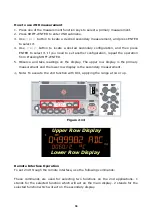
25
2.4 Resistance Measurements (2 & 4-wire)
The ranges for resistance measurement are 100 Ω, 1KΩ, 10kΩ, 100kΩ, 1MΩ, 10MΩ,
and 100MΩ, with a sensitivity of 100 μΩ
(at
100 Ω range.) There are
two modes for
measuring the resistance: 2-wire mode as shown in
Figure 2-4
and 4-wire mode as
shown in
Figure 2-5
. With 4-wire mode, the test current is measured from the test
resistance through one pair of the test leads, and the test voltage across the
resistance under test is measured from another set of the test leads. As a result, the
4-wire mode is more accurate for low resistance measurements. The trade off is the
longer settling time for 4-wire mode.
How to measure resistance
1.
Connect the test leads to the terminals as shown in
Figure 2-4
(2-wire) or
Figure
2-5
(4-wire).
2.
Set RESOLUTION (refer to 3.1.3 Resolution & NPLC Setting) or skip this step to use
the default setting.
3.
Press Ω2 button for 2
-
wire measurement or SHIFT+Ω2 buttons for 4
-wire
measurement.
4.
Select the auto-range function by pressing SHIFT+ESC button on the front panel or
use
△
and
▽
buttons to manually select the desired range.
5.
Connect test leads to your source signal and observe readings shown on the
display. If the input signal is greater than the allowed range, an overflow message
“OVLD” will be displayed.
Figure 2-4
Figure 2-5
※
Note: Ensure the chassis ground is leaded to the ground before measurement in
order to prevent the measuring deviation.






























